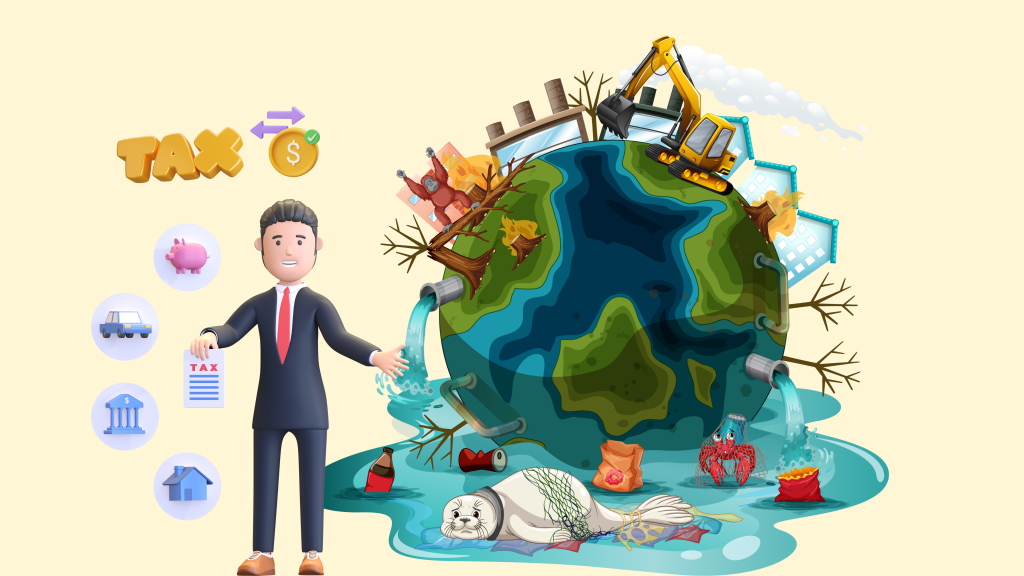Historical Polluter Tax Should be imposed for European Union instead of Carbon Border Adjustment Mechanism for India. Countries that have not historically contributed to the climate crisis may consider imposing a ‘historical polluter tax’ on trade partners to fund their own decarbonization efforts Says the Centre for Science and Environment(CSE) report which released a report titled “The Global South’s response to a changing trade regime in the era of climate change”. So India asks Europe to pay for its own past karma instead of burdening the developing countries for their own deeds.
Net-zero carbon emission is ideally a global goal. When the equation balances worldwide, global warming will plateau—so the world should aim to reach net-zero before temperatures rise beyond the 1.5 degree Celsius increase from pre-industrial levels set as a target in the 2015 Paris Agreement. To avoid the worst consequences of climate change, the deadline is 2050. In reality, there is no global authority that can compel the world to meet this deadline. Net-zero efforts are therefore a patchwork of governments, companies, and organizations of all sizes.
What is Historical Polluter Tax??
The Historical Polluter Tax is a policy proposal aimed at addressing environmental damage by holding historically significant polluters accountable for their past emissions and environmental harm. The concept is based on the principle of “polluter pays,” which asserts that those who cause pollution should bear the costs associated with managing and mitigating its effects.
European Union Net zero carbon emission Plans
- As the European Union’s aim to reach greenhouse gas neutrality by 2050 begins to be filled with concrete measures, the bloc has begun to look beyond pure CO2reduction to tackle the large share of hard-to-abate greenhouse gas emissions.
- Getting to a net-zero economy means the EU will have to capture emissions from certain industrial processes and store it underground and tackle residual emissions in livestock farming by removing an equivalent amount from the atmosphere.
- This could happen through nature-based methods, such as reforestation, or technological solutions, like direct air capture (DAC).
- However, Europe still faces significant hurdles until a well-functioning management system to store and use carbon emissions is in place, including costs to ramp up an EU-wide market and the necessary infrastructure.
- European countries like Norway are frontrunners, while EU member states like Germany have only begun to draft their own strategies on CCS, CCU and negative emissions.
What is European Union Carbon Border Adjustment Mechanism (CBAM?)
- CBAM, announced in 2022 by the EU, places a tax on imported goods such as iron and steel, cement, aluminium, fertilisers, electricity and hydrogen, based on the GHG emissions intensity of production of these goods. Such Policies place the burden of decarbonising heavy industrial sectors on the Global South, and act as roadblocks in the path of development.
- CBAM is aimed at cushioning the EU’s firms from competitors who can manufacture more cheaply in countries that do not subject them to a carbon price. The EU also believes that the tax would incentivize its trading partners to decarbonize their manufacturing industries.
India to loose 0.05% of its GDP due to CBAM
- The European Union’s Carbon Border Adjustment Mechanism (CBAM) is set to impose a 25% tax on carbon-intensive imports from India, potentially reducing India’s GDP by 0.05%. As per experts India should implement a ‘historical polluter tax’ on EU nations to offset the economic impact and support domestic decarbonization efforts. CBAM is the EU’s proposed tax on energy-intensive products, such as iron, steel, cement, fertilisers and aluminium imported from countries like India and China. This tax burden would represent 0.05% of India’s GDP.
- The tax is based on the carbon emissions generated during the production of these goods. The EU argues that this mechanism creates a level playing field for domestically manufactured goods, which must adhere to stricter environmental standards, and helps reduce emissions from imports.
- But other nations, particularly developing countries, are worried this would harm their economies and make it too expensive to trade with the bloc. The move has also sparked debate at multilateral forums, including UN climate conferences, with developing countries arguing that under UN climate change rules countries cannot dictate how others should reduce emissions.
- India’s CBAM-covered goods exports to the EU accounted for 9.91% of its total goods exports to the bloc in 2022-23. 26% of India’s aluminium and 28% of its iron and steel exports were destined for the EU in 2022-23. These sectors dominate the basket of CBAM-covered goods shipped from India to the EU. In 2022-23, the exports of CBAM-covered goods to the EU made up about one-fourth (25.7%) of India’s total such goods exported globally, which is significant for the industries operating in these sectors.
- Currently, hydrogen and electricity are not exported from India to the EU. Of India’s total goods exported worldwide, CBAM-covered goods exports to the EU constitute only about 1.64%.Historical trends indicate that carbon-intensive production has shifted from developed to developing countries, creating disparities in emissions intensity between nations.
- Today’s differences in emissions intensity are also tied to historical emissions, as the Global North utilized fossil fuels like coal during the early stages of the Industrial Revolution which enabled it to amass wealth and grow its economies. The imposition of a CBAM overlooks this historical context and unfairly penalizes the Global South. It is not retaliation, but rather a necessary course correction for the South to impose costs on the North for years of cheap polluting energy use, offshoring, and reliance on inexpensive offsets
- Countries like India could institute their own carbon tax on exports of CBAM products destined for the EU or any country imposing a carbon border tax. Revenues generated from a domestic carbon tax could be directed into a government-managed fund to support the decarbonization efforts of Indian industries. By collecting a carbon tax domestically India can exert greater control over its mitigation strategies and achieve decarbonization more effectively.
The way ahead
- The EU should set aside revenue from CBAM to aid the decarbonization of manufacturing in developing countries as a necessary step. Shifting to low-carbon processes demands substantial financial resources and technological advancements – which many developing countries currently lack. Moreover, it must increase overall flows of climate finance towards developing countries, and exempt the most vulnerable countries from bearing any tax burden. Developing countries can proactively take steps to mitigate CBAM’s liability, while also transforming their manufacturing sectors to shift towards low-carbon processes.
- In line with their demand for financing, developing countries must have sectoral mitigation plans in place outlining specific measures and targets for emissions reductions in key emitting sectors of their economies. This is essential to align their domestic strategies with their unique needs and avoid the impact of top-down prescriptions from the international community which may fund solutions not appropriate for them. By aligning climate finance with these sectoral mitigation plans, the EU could be assured that its support is targeted and impactful, maximizing the effectiveness of its financing for decarbonization efforts.
- To mitigate the impacts of paying the tax to the EU (or any country imposing such a mechanism), developing countries may consider taxing their goods domestically at the point of exports, and cycling the funds into a government-managed decarbonization fund. This fund can then be utilized by industries to shift to low-carbon production processes and reduce their greenhouse gas (GHG) intensity. This approach satisfies the EU’s requirement for the existence of a domestic carbon pricing mechanism, in this case, a carbon tax, and does not disrupt fair trade conditions with the EU. Moreover, it retains the funds within the developing country.
- As an interim measure, developing countries may consider diversified production processes for different markets and trade partners. Allocating green production processes to goods destined for regions imposing a CBAM could be an interim step while the country’s manufacturing sector gradually decarbonizes. This would mean reserving less carbon-intensive production for markets that prioritize environmental considerations over price. Industries can thus achieve multiple objectives: engineering industrial outputs to minimize the costs of CBAM-like measures and buying time to decarbonize overall at a fairer pace.
- If climate policies are to permeate trade agreements, climate justice must be at the core of this development. This requires India to consider the burden-sharing aspect of climate policy in trade as well. In this light, a system should be introduced where developing countries could impose a ‘historical polluter tax’ on trade partners to fund their own decarbonization efforts.
- This tax could be imposed on trade partners responsible for a certain share of cumulative historical CO2 emissions since the pre-industrial period. The impacts of policies like CBAM must be minimized so that the developmental process in the Global South is not hindered, and can be achieved through low-carbon, climate-resilient pathways with adequate financing and technology support from developed countries.







